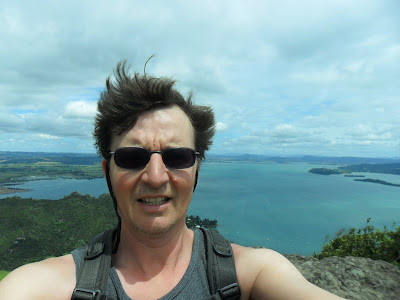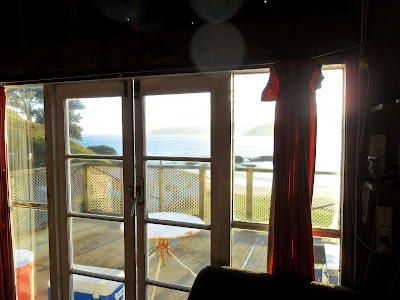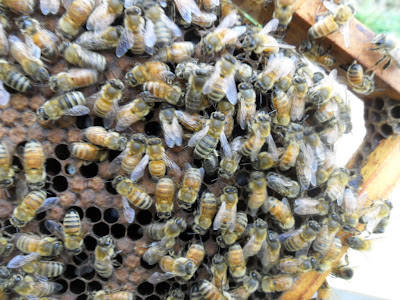Thursday, January 24, 2013
Summer holiday
Last week we were all at MacLeods Bay a seaside village on the shore of Whangarei Harbour. We rented a little cottage - or bach as they call them here. It was a basic but perfectly acceptable place to base orselves. We had hoped to do a lot of kayaking as the water started just over the road from the house. As it happened the wind blew directly onshore most of the time which makes for an unpleasant experience. We did get out for one morning fish and caught just one keeper snapper and dozens of much smaller ones.
Chantelle and I hauled our aging bones up the path to the top of Mount Manaia. Superb views from the top. The descent was the worst bit and both our calves ached for about a week aferwards.
Sunday, December 23, 2012
Garden Safari 2012
Going back in time. Blogger does not let you move posts.
More stuff from the archives.
Spent one pleasant day looking at a number of gardens in the Ahipara general direction. It is always good to see what other people are doing with their land. Sometimes I am inspired with new ideas for combinations or designs. Often I see things that I do not like. It helps to crystallise what works for me and what does not. My stan out favourite garden was that of Eric and Sandra Shackleton. They have a large property in the Pukepoto hills with views along Te oneroa aTohe to Mt Camel and beyond. A large part of the property is taken up with a commercial vineyard. We sampled some of thewines and particulary liked Quails run. Eric told us all about the nuances of the grape varieties that he uses. We also liked the native planting on several acres of steep hillside. Eric reckoned that he had put in over 80,000 trees. It was QEII covenanted to keep it for ever. We also had a look inside his house and were impressed by its coollness and features.
I did not really take to any of the gardens in Ahipara. There were a few things that i did like. Like a planting of Alyssum on a she=ll path in one small garden. There were lots of succulents and sand plantings. Clarries and mare's garden was the best of them as it blended native with moexotic and screened the neighbours well. We visted a carver along the foreshore and his detailed work was very impressive. Roll on another year and well done to Kaitaia RDA for organising it.
What happened in Term Four?
What did happen in Term four? Must have been busy because I did not get around to updating the blog.
I shall have a look in the picture folders to remind myself what happened.
We spent a great weeknd at lane Cove with Nicky and Phil and their children.
It was the weekend before the end of year exams started so Eric took his economics books with him. The rest of us enjoyed the fine weather and spent a lot of time on the water, kayaking, boating, fishing and swimming.
Saturday, October 13, 2012
Holiday walks
Went for a cracking bush walk with Hal last weekend. We were aiming to reach the summit of one of the local hills called Puketutu. NZ bush is quite different to UK woodland. The tracks tend to be indistinct. The undergrowth is thicker. There is sign of wild pigs. It is rare to meet anybody else.
We made it to the top. At least we thought we were at the top! The hills are forested right to the tops round here so you rarely get a view. We had planned to walk along theridge to a quarry and then back to the car. Without GPS this was going to be tricky as it was hard to tell where the ridge was. So we played it safe and walked down the valley back to the car. It still took us 6 hours to complete a short ascent and descent.
The picture of eggs, beans and asparagus shows the produce from the garden. It is a slow spring in terms of getting veggies from the garden. The broad beans have been badly affected by the chocolate spot disease and so their yield has been low. This time of year is critical in the garden though. There is a narrow window of opportunity for preparing the soil while it can be worked. By the middle of the week we had had no rain for a week and the recently dug soil had set into sun baked clay. The addition of a large barrow of compost made it possible to stick in a row of peas and haricot beans. Frost cloth is protecting the early cucumbers and courgettes from the cold winds. I went down twice in the evening with a head torch after the rain started to harvest snails. I collected about 400 the first night and 100 on the second. The chooks love eating snails so I throw them a handful most days.
Saturday, October 06, 2012
Walking around Russell
1. The flag staff that Hone Heke cut down 4 times back in the 1840's because he was not impressed with the way that the British were dealing with Maori. I notice that now adays the flag staff is made of axe proof metal. Also that someone has scratched "Hone" into the paint.
2. The view of Russell from the flag staff.
3. Tapeka point at the top of the Russell Peninsular, looking out towards Bay of islands and Roberton Island (I think).
4. Sunset from our motel looking towards the flag-staff. If the picture had sounds you might be able to hear a kiwi calling. That would be a video, and I did not take one, being keen to eat the rather nice steak that was waiting.
Russell
Chantelle and I have just returned from a pleasant mini-break at Russell. Formerly known as Korororeka by Maori (literally "sweet penguin"), then nick-named "the hell-hole of the Pacific" because of the debauchery caused by drunken uncouth European whalers who used it as a base in the 1800's. It has now become a very genteel sea-side resort where the loudest calls at night belong to kiwi. Somewhere along the way most of the Maoris seem to have moved out.
We visited Waitangi - the birth-place of the NZ nation - for the first time. Very civilised in a European way. A large expanse of grass with a little museum explaining how a treaty was signed there between the British Crown and some of the Northern Maori Chiefs back in 1840. By all accounts it was a hastily cobbled together document with 2 versions. One was written in English. This was translated hurriedly overnight by a local missionary into Maori. The ensuing discrepancies have led to all manner of argument. There is a huge legal business that exists to try to interpret modern questions of ownership and seeks to redress past injustices. As an Englishman who has lived with concepts of private property and a deeply injust class sytem all my life, it is ... stimulating? ... surprising? ... to move to a country where colonialism is still being challenged generations after the main land-grab took place. I suppose that Waitangi being central to NZ culture is a testament to the staying power of Maori. I do wonder where things will be in another generation if the injustices can be re-dressed and society can move on.
Anyway back to the pics. We were taken with the massive boat beautifully carved from several kauri trees. Chantelle is pictured inside one of the 3 trees that were used. The waka can seat about 80 paddlers.
Alongside the colonial residence of James Busby was an ornately carved marae.
Last week of term
In the last week of term Chantelle and I went long lining at Puwheke with Pat and Edwin. It is a good way to relax after work. Especially when Pat did the hard work of paddling the kayak out with the line - twice! Chantelle cooked up some sausages on a beach bbq leaving me with little to do but take photos and drink tea with Edwin. We caught 3 fish on those 50 hooks. One pufferfish as shown in the photo. Not edible but beautiful in a grotesque sort of way with those spines. Also a small stingray and a small gurnard. As a wise woman once said, at least we were not relying on our trip to feed our families. Quite a luxury, but it has been a long hard stressful term so I for one do not feel guilty.
The third picture shows my unsuccessful attempts to manipulate my little bee-hive. Apparently one can build up a bee colony at this time of year by feeding them a thick syrup of raw sugar. So far the wasps have appreciated this extra food, and once I got rid of them a large colony of ants moved in. The bees have turned up their probosci at my attempts to help them. Perhaps they see through the amateurish attempt at manipulation.
Final picture is our rabbit. Nuff said.
Friday, August 31, 2012
Asparagus
On Sunday I was feeding the chooks fairly early in the morning and thought to check the asparagus for some early spears. I was delighted to see the first ones poking through their bed. What a great indicator of the arrival of spring.
They were snapped off, given a quick boil, annointed with butter and a dash of home grown lemon and then served up within the hour for Chantelle's breakfast.
I snuck one off the plate just to make sure it was edible ... and it was very nice. So the asparagus bed is on the daily circuit to see how the rest of the crop is coming on. Home gardening is in one sense very inefficient, as you put in a huge amount of "work" for often a very poor yield. There are so many threats and obstacles in the way of any one crop coming to fruition. For example, I can plant up a whole bed of raspberries, manure them, prune them, lime them, keep them weeded and watered all the year. If I fail to stick a net over them then I will lose 99% of the crop to song thrushes and blackbirds. Often your entire crop of one veggy fails for no obvious reason one year and then does really well the next.
Hence my delight at getting some produce onto the plate in tip-top condition.
Saturday, August 25, 2012
Bee inspection
The bee inspector came round this morning to see if my bees were healthy. I was a bit nervous about this because there is a serious bee affliction called American Foulbrood that is common in this area. It is a bacterial disease that attacks the baby bees before they hatch out. If you find AFB in your hive, you have to pour petrol into your hive at night to kill all the bees and then burn the whole hive in a pit in the ground. Fair enough as the bees apparently do not recover and will just spread AFB to other hives.
So, faced with the potential prospect of losing my one hive, I felt a bit like you do when sat in the doctor's waiting room. Ian has 10 year's experience of bee-keeping and has a DECA certificate that shows that he can recognise AFB. He declared my hive to be healthy apart from having the less deadly varroa mite. I will need to get some insecticide strips in to treat the varroa, but that is preferable to losing the whole lot. It was great to watch someone who knew what was going on. He re-organised the frames to make the bees happier and showed me lots of useful tips for how to make my bee-keeping better.
Thanks very much Ian!
The pictures show the inspection, frames of pollen, nectar and brood (bee babies). If you look carefully you might also be able to see the queen. She has a longer body than the workers and so her wings look shorter.
Saturday, August 11, 2012
Rain, rain go away, come back next year.
We need rain in the winter to re-charge the groundwater, our dam, fill up the water tank and generally see us through the dry, hot summer.
Now, I think we have had enough rain. We are into our second week of daily grey and wet. We have had about 10mm every day on average for 2 weeks. So, that's enough thanks.
The pictures show the effects of this moisture on the garden. Gloopy mud on all the paths, sodden beds and depressed looking grass. It remains warm enough for some plants to keep moving. In fact it has been remarkably mild the last week or so. The main crops I have in at the moment are the garlic, the broad beans and the mustard. The garlic will sit through this weather without any problems. I put it in a month earlier than I usually do in the hope that the bulbs will not split like they did last year. The broad beans are partly there for eating and partly as a seed crop for school. They also give the bees some forage and finally act as a soil improver: they add nitrogen and keep the soil structure more open than a bare bed would. The mustard is another over-wintering green manure. It has a yellow flower and I will have a go at saving some of its seed in due course. The chooks like eating the big plants and it makes a change for them from eating grass.
The chooks are laying pretty well at present. They have a break just before the solstice as the days get really short. Just before the shortest day (June 21st) the first hens started laying again. We get about 5 - 8 eggs every day from 13 chooks. That means we can have a couple of egg dishes a week, never need to buy eggs and can even barter the surplus.
One picture shows the view down the hill towards the middle field. We planted 6 more olives on the hill this winter. Along the pathway we have planted apples and other deciduous fruit trees. On the left a band of native trees is going in. I had tried growing forest trees out in the open in this area. Species such as kohekohe and taraire. After they kept dying I pondered on why this might be. I suspect that they do not like to grow straight into grass with no shade or shelter from the wind. The latest plan is to plant a mixture of karo, coprosma and guava for the first five years. As these establish, they will shade out the grass reducing the need to mow. The guava will hopefully attract pigeons in and these will crap out native seed in their shit. These will be able to grow into the bare soil and will do much better. That is the plan. Check back in 10 years time to see if it works!
Subscribe to:
Comments (Atom)


















































